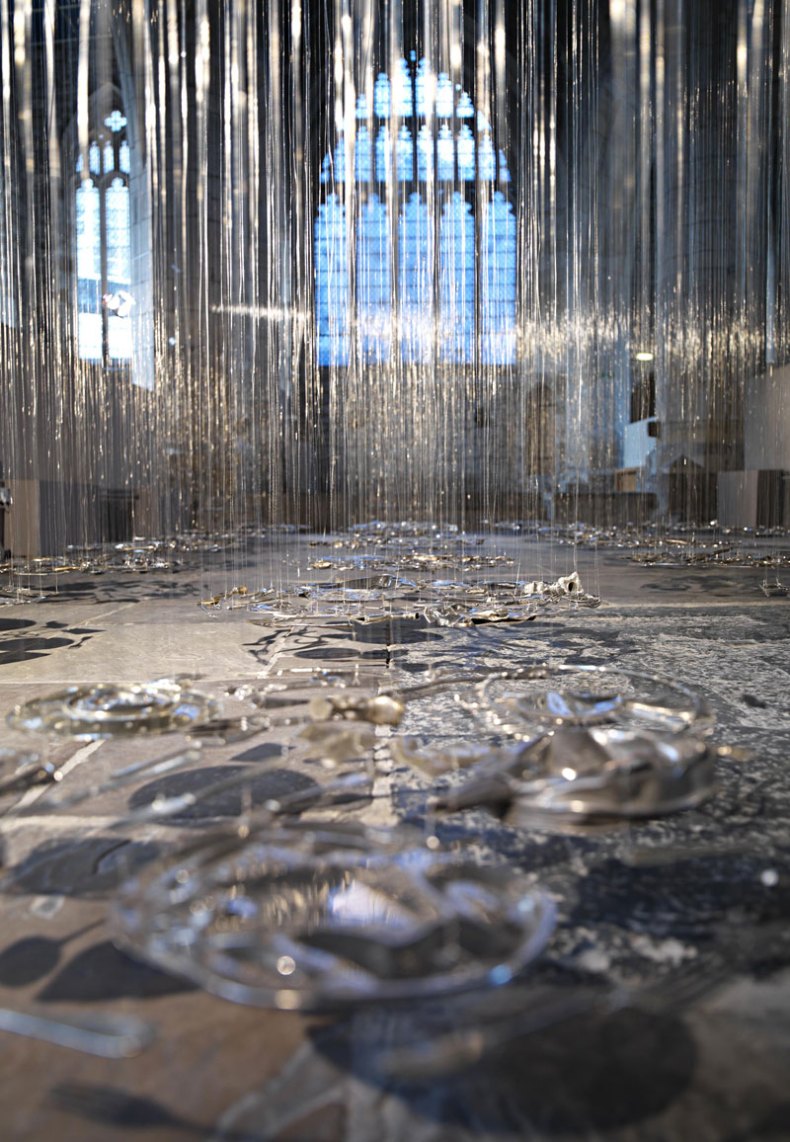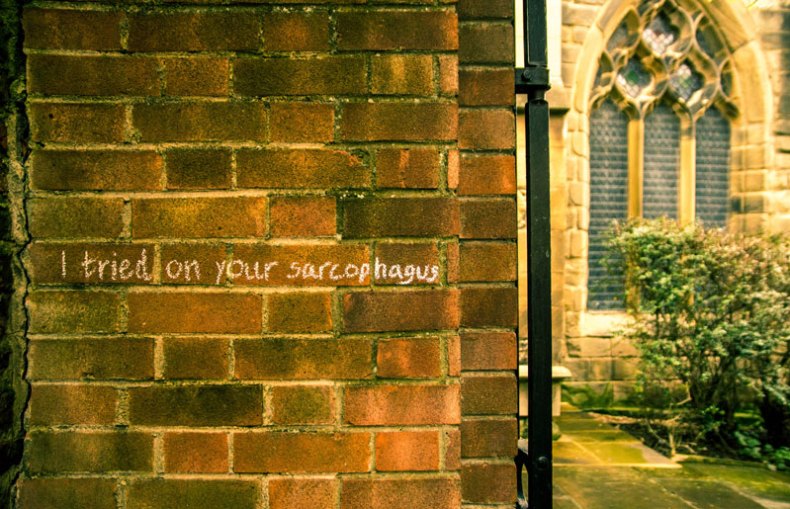York is a city that challenges visitors not to find it beautiful. The honey-coloured medieval architecture can feel like it’s preserved under a snow-globe, fundamentally unperturbed by intermittent shakes from the tourist buses that rumble through. Charm and history, however, can pose their own challenges.
Not far from York lies the Yorkshire Sculpture Triangle, comprising the Hepworth Wakefield, the Yorkshire Sculpture Park, the Henry Moore Institute and the neighbouring Leeds Art Gallery. These institutions, each of which has established a unique identity, together offer a compelling and adventurous array of contemporary exhibitions – from the US sculptor Lynda Benglis’s day-glo poured polyurethane floor-pieces, to the Venezuelan artist Gego’s intricate wire sculptures.
It’s hard to imagine the slate-coloured abstractions of David Chipperfield’s celebrated design for the Hepworth Wakefield appearing in York’s heritage environment. It’s difficult even to conjure up the York equivalent of the minimalist granite façade which graces the front of the Henry Moore Institute. It might seem that those in search of contemporary art could shuttle along the three axes of the Sculpture Triangle and bypass York entirely.
Yet this would be a mistake – especially now that the York Art Gallery has re-opened after a major refurbishment. While its new spaces offer fantastic possibilities for exhibitions, commissions and education projects, other sites have also been thinking creatively about how to integrate contemporary works into the city fabric.

Thirty Pieces of Silver (detail), by Cornelia Parker in York St Mary’s. Photography by Shannon Tofts
York St Mary’s, a church belonging to York Museums Trust, has led the way. Its programme has included Cornelia Parker, who suspended gleaming pools of flattened metal from the ceiling for her 2011 installation Thirty Pieces of Silver, and a 2013 display of works by Bruce Nauman drawn from Tate’s Artist Rooms lending collection.
For the past three years, York St Mary’s has housed the Aesthetica Art Prize exhibition, which showcases winning entries from the competition, spanning photography, painting, drawing, video, installation, performance and sculpture. In 2012, York Treasurer’s House hosted a residency by Inheritance Projects, which saw Laure Prouvost create installations in the National Trust-owned townhouse near York Minster. York Curiouser, an enterprise that inserts ephemeral artworks into the streets, mirrors this approach. Oui performance, which was first founded because of the lack of infrastructure for live art in the Yorkshire region, has organised a number of site-specific performances at locations throughout the York during the last decade.
Sustained cuts and austerity make it particularly difficult for smaller towns and cities to support experimental contemporary practice. In York, the trick has been to work with rather than against the historic landscape; it will be fascinating to see how the refurbished York Art Gallery contributes to these initiatives.

Line from a poem by John Wedgwood Clarke: installation by York Curiouser. Photo by Chris Jones
Lead image: used under public domain licence

The great contemporary art hidden in York’s historic buildings
York St Mary's hosts a surprising programme of contemporary art interventions. Photo: Poliphilo/Wikimedia Commons
Share
York is a city that challenges visitors not to find it beautiful. The honey-coloured medieval architecture can feel like it’s preserved under a snow-globe, fundamentally unperturbed by intermittent shakes from the tourist buses that rumble through. Charm and history, however, can pose their own challenges.
Not far from York lies the Yorkshire Sculpture Triangle, comprising the Hepworth Wakefield, the Yorkshire Sculpture Park, the Henry Moore Institute and the neighbouring Leeds Art Gallery. These institutions, each of which has established a unique identity, together offer a compelling and adventurous array of contemporary exhibitions – from the US sculptor Lynda Benglis’s day-glo poured polyurethane floor-pieces, to the Venezuelan artist Gego’s intricate wire sculptures.
It’s hard to imagine the slate-coloured abstractions of David Chipperfield’s celebrated design for the Hepworth Wakefield appearing in York’s heritage environment. It’s difficult even to conjure up the York equivalent of the minimalist granite façade which graces the front of the Henry Moore Institute. It might seem that those in search of contemporary art could shuttle along the three axes of the Sculpture Triangle and bypass York entirely.
Yet this would be a mistake – especially now that the York Art Gallery has re-opened after a major refurbishment. While its new spaces offer fantastic possibilities for exhibitions, commissions and education projects, other sites have also been thinking creatively about how to integrate contemporary works into the city fabric.
Thirty Pieces of Silver (detail), by Cornelia Parker in York St Mary’s. Photography by Shannon Tofts
York St Mary’s, a church belonging to York Museums Trust, has led the way. Its programme has included Cornelia Parker, who suspended gleaming pools of flattened metal from the ceiling for her 2011 installation Thirty Pieces of Silver, and a 2013 display of works by Bruce Nauman drawn from Tate’s Artist Rooms lending collection.
For the past three years, York St Mary’s has housed the Aesthetica Art Prize exhibition, which showcases winning entries from the competition, spanning photography, painting, drawing, video, installation, performance and sculpture. In 2012, York Treasurer’s House hosted a residency by Inheritance Projects, which saw Laure Prouvost create installations in the National Trust-owned townhouse near York Minster. York Curiouser, an enterprise that inserts ephemeral artworks into the streets, mirrors this approach. Oui performance, which was first founded because of the lack of infrastructure for live art in the Yorkshire region, has organised a number of site-specific performances at locations throughout the York during the last decade.
Sustained cuts and austerity make it particularly difficult for smaller towns and cities to support experimental contemporary practice. In York, the trick has been to work with rather than against the historic landscape; it will be fascinating to see how the refurbished York Art Gallery contributes to these initiatives.
Line from a poem by John Wedgwood Clarke: installation by York Curiouser. Photo by Chris Jones
Lead image: used under public domain licence
Share
Recommended for you
Highlights from the new Centre of Ceramic Art in York
Our picks from the impressive collection at the renovated York Art Gallery
Yorkshire Sculpture Park named Art Fund’s Museum of the Year
‘A perfect fusion of art and landscape’ the YSP has been named Museum of the Year 2014
Rule Breaker: Lynda Benglis
As a survey of Lynda Benglis’s work opens at the Hepworth Wakefield, the artist talks to Imelda Barnard about her 40-year career